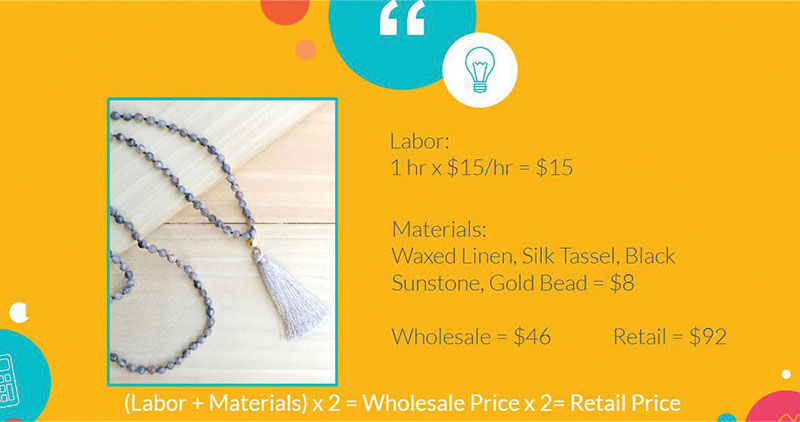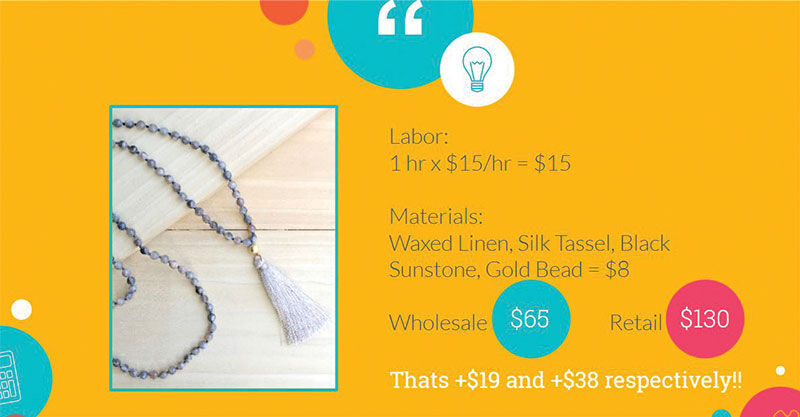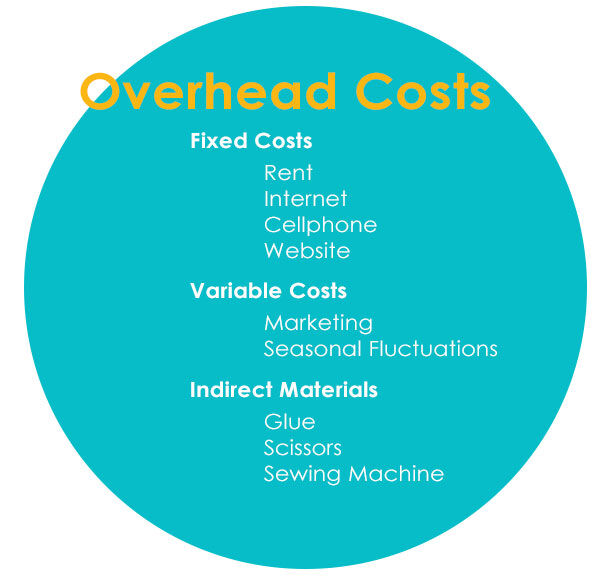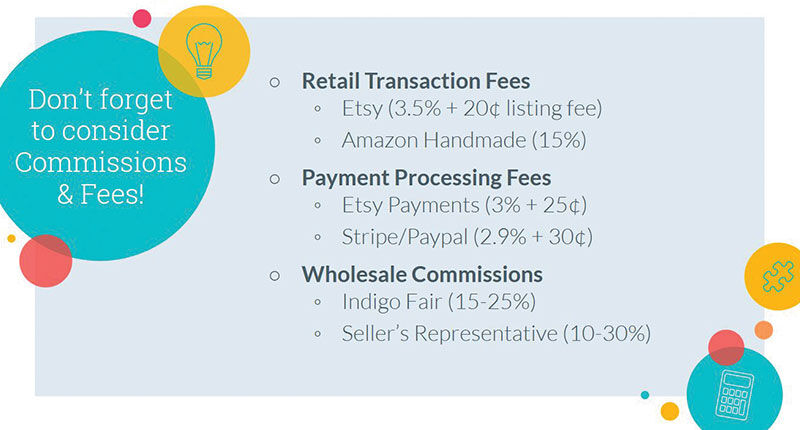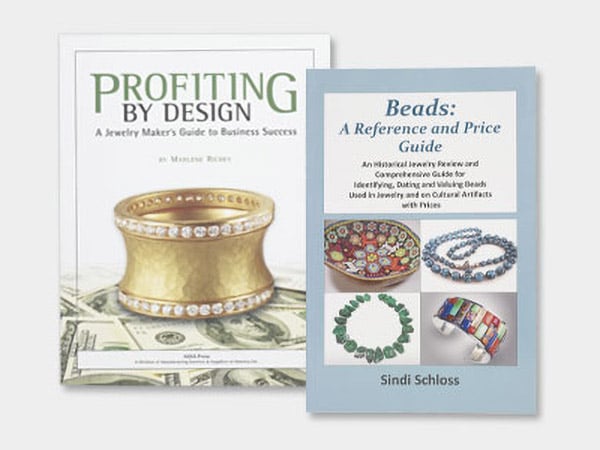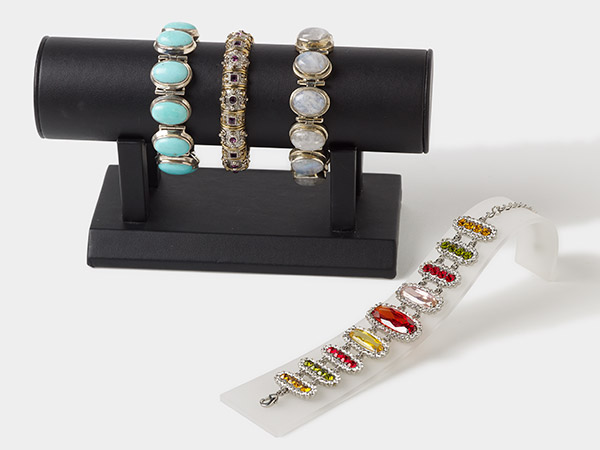The Price is Right
by Melissa Jones
"I was underpricing my jewelry significantly,'' shared Elizabeth, a co-worker and handmade artist. ''I have been creating handmade art for the past 6 years and only taking into account my material costs. I wasn't accounting for my time or establishing a wholesale price for my work. I realized after attending this pricing webinar, how valuable my time and skill set are, and I immediately put it into action.''
Elizabeth continues, ''A friend had commissioned me to make a piece of jewelry as a gift for a friend. I originally was going to charge $35 for the piece, but after viewing the webinar I put all of my information into the pricing calculator that was included and discovered I should be charging $70. I stepped out on a limb and let her know it would be $70. To my amazement, she responded with 'Oh, that's great'. I had no idea that my buyers thought my work was worth this much, but it is, and I've changed how I price my items.''
You probably don't even realize that you're underpricing your work. One swipe through this webinar and plugging the numbers into the calculator is an eye-opener and could be the difference between profit and loss. Adrianne Stone, the creator of the Deluxe Pricing Calculator (included with the webinar), has thought of everything when it comes to pricing. Her background as a handmade maker, a software developer, and the owner of Stockabl, has given her first-hand experience.
Pricing misconception
Most people adhere to what is referred to as the ''simple'' formula for pricing. ''The 'simple' formula can actually put you out of business because it's ignoring simple elements such as overhead costs, which aren't factored into that formula at all. And it doesn't account for profit margin needs that are specific to your business,'' Adrianne states. ''It also doesn't take into account retail markups that are in-line with your industry,'' and ''it leaves out the commission and fees you need to pay others.'' Although it's simple, this formula may be too simple in that it doesn't help you even calculate your own labor fees.
It is important to remember when pricing that ''you are not cutting your retail prices in half for wholesale. You are marking up your wholesale prices double, or more, for retail!'' Meaning, it's important to have your wholesale price set first which should include all the costs. The wholesale price should encompass everything from labor and materials, to profit margins and fees. After you find the price that covers everything using the webinar included pricing calculator you will get your wholesale price. This is the price you double for retail.
Labor costs
It is very important to factor in labor costs at the beginning before you even have production assistance. This helps you plan for the future and have money to pay for labor down the line if it's needed. It allows you to plan for growth! However, what you want to pay for assistance you have to factor in for a little more. For example, if you want to pay them $10 an hour you have to factor in paying them $15 to $20 an hour. This is because fees and expenses often get forgotten when it comes to production assistance. A couple things that get left out are taxes and insurance for the employee. Planning for the future is vital to your handmade business. Factoring the cost of production assistance at the beginning means you don't have to suddenly raise your prices to pay for the assistance when you need it.
Material costs
All handmade business owners have material costs. It was surprising how some of the simple things don't get accounted for. Obviously, you have to factor in the cost of the supplies that are needed to make your pieces. Some things to keep in mind are any shipping that you paid in order to get your materials, any packaging that you must use for your product, and fluctuating material costs.
Overhead costs
There are three types of overhead costs discussed in the webinar. The three overhead cost types are fixed, variable and indirect materials. If you are wondering what exactly constitutes an overhead cost, it is ''expenses for running your business that can't be directly tied to a specific item that you sell. Basically, this is anything that is not your materials or your labor,'' according to Adrianne. She goes on to explain three rates that work best for calculating overhead cost for makers – flat rate, hourly rate and percentage rate. The webinar also explains what type of makers would benefit the most from each type of rate. Adrianne does a great job of explaining how to calculate the overheard costs as well as the rates that work best and why.
Comissions, fees, margins and markups
There are extra costs that don't get factored into overhead costs because they are individualized. These costs are more dependent on how you choose to wholesale or sell your pieces. Examples of these fees would be retail transaction fees, payment processing, and wholesale commissions. It's important to factor these costs into your overall price in order to help turn over a profit.
The deluxe pricing calculator
Along with the webinar comes a deluxe pricing spreadsheet that calculates everything for you and tells you what you should be selling your pieces for. This spreadsheet calculates all the overhead costs as well as material and labor costs. The pricing calculator comes complete with separate tabs to help you figure out all of your costs. It basically breaks down your entire business and tells you how to make a profit. Not only are you paying for first-hand knowledge on proper pricing, but you are also getting the deluxe pricing calculator. Elizabeth says, ''the webinar itself has been invaluable to me,'' and after just one sale ''it has already paid for itself.''
Perception and pricing
Your price influences a lot of your sales. Other than just factoring your costs, there are a couple little things to think about with regards to perception. Display, pricing and emotions are important when selling your pieces. If you price pieces significantly lower than your competitors, it may send the message that your product is of a cheaper quality. This is because buyers tend to think that if the same item was priced at 7 dollars, 50 dollars or 250 dollars the buyer is going to perceive the materials are different for each price. The higher the price the better perceived quality, time and craftsmanship the buyer will think went into it. This doesn't mean it's true. Unfortunately, perception is a fickle thing. Taking quality pictures of your products will help them sell better as well. The buyers also base the quality of your pieces on how much time and energy you put into showing your appreciation for the pieces in photos.
Pricing can make or break you in the wholesale world. So why not do it right and learn from someone that is a successful handmade business owner among other things.
Shop for Your Materials Here:
Have a question regarding this project? Email Customer Service.
Copyright Permissions
All works of authorship (articles, videos, tutorials and other creative works) are from the Fire Mountain Gems and Beads® Collection, and permission to copy is granted for non-commercial educational purposes only. All other reproduction requires written permission. For more information, please email copyrightpermission@firemtn.com.


